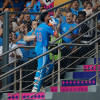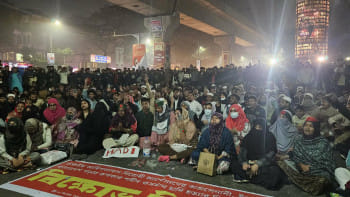Time for a new chapter in the story of Bangladesh cricket

When you want to tell the story of Bangladesh cricket, you have to decide where to begin first. For our purposes, we can start with the cricketers from this region who had a love for the game in their hearts and a bat in their hands, but were forced to operate under oppression. The name of Raqibul Hasan pops off the pages of history books – he who dared to walk out with a "Joy Bangla" sticker on his bat while batting for Pakistan in a four-day match in Dhaka in February 1971. Then there was Abdul Halim Chowdhury Jewel, who may not have lived to achieve all his goals between the wickets, but he died trying to liberate his country. His name, and the name of his mentor Mushtak Ahmed, who was killed during Operation Searchlight, adorns the north and south stands at the Sher-e-Bangla National Cricket Stadium in Mirpur, Dhaka.
Struggling to survive in the depths of post-war misery, we were lost in the wilderness that is the associate membership of the International Cricket Council (ICC). Eventually, the first One Day International (ODI) was played and lost in 1986 against Pakistan in the Asia Cup, but we finally had a start.
A flood-ravaged Bangladesh hosted its first tournament, another Asia Cup, in 1988. The 1990s saw a more concerted push in cricket. Bangladesh kept playing high quality opposition in various tournaments, and losing, but quietly improving during this decade. It all led to what is possibly the most pivotal moment in Bangladesh cricket.
Dizzying success in 1999 was followed by what many now consider premature recognition. Test status meant Bangladesh was now one of top 10 countries in cricket, but the results were different. Bangladesh went to the 2003 World Cup without winning a game of cricket since that 1999 victory against Pakistan. That did not change during the World Cup.
The journey that started with the 1997 ICC Trophy for Bangladesh went beyond anyone's wildest imaginations. An easy win in the semifinals and then a closely fought, rain-curtailed final with Kenya led to the promised land – qualification to the 1999 ICC Cricket World Cup.
The 1999 World Cup was when Bangladesh cricket finally came into common consciousness. It was a fever dream of a tournament, and Bangladesh registered their first World Cup win against Scotland on May 24. What happened a week later in Northampton, however, lives on in legend.
Pakistan was one of the favourites in the tournament, eventually making it to the final. But in Northampton, when Khaled Mashud Pilot whipped off the bails and appealed for a runout, and Bangladeshi supporters in the stadium rushed into the field even before the TV umpire could give a decision, Pakistan was the team that Bangladesh had just defeated to announce themselves on the world stage.
Dizzying success in 1999 was followed by what many now consider premature recognition. Test status meant Bangladesh was now one of top 10 countries in cricket, but the results were different. Bangladesh went to the 2003 World Cup without winning a game of cricket since that 1999 victory against Pakistan. That did not change during the World Cup. Memory of the loss against Sri Lanka lives fresh in my mind as a four-year-old watching the game on a 21-inch TV in my grandparents' living room. Chaminda Vaas took four wickets in the first over for Sri Lanka, and Bangladesh succumbed in a sad surrender. The team that captured the imagination four years ago tainted perceptions this time. The stalwarts of 1999 had left the team, and the youngsters were either too young or just not good enough.

It wasn't until March 2004 that Bangladesh finally won another game of cricket. Later that year, in Bangladesh's 100th ODI match, the opponent was India and an unlikely win buoyed the team. Images of a young Mohammad Ashraful hopping off the field in unbridled joy was rare and refreshing. The first ever win in Test cricket followed in 2005, and Bangladesh started winning games with some regularity. Surprise wins against Australia and Sri Lanka, accompanied by regular wins against Zimbabwe meant the team was confident going into the 2007 World Cup.
One wonders what the selectors were thinking when they included Shakib Al Hasan, Tamim Iqbal and Mushfiqur Rahim in the squad for the 2007 tournament. One assumes that it wasn't predicted that these players, all between the ages of 17 and 19 then, would score three half centuries to upend the mighty Indians, with the whole country staying up watching the game on TV in the dead of night. But even that may not have been the highest point in that World Cup. The best team in the world at that time, South Africa, were next in line to lose to Bangladesh. On a slow, tacky pitch, Bangladesh spun a web of spin against the Proteas, defending 251. The 2007 World Cup also included a shock loss against a nascent Ireland, but that was rightfully overshadowed by the two huge successes against India and South Africa.
Between the 2007 and 2011 world cups, the mantra around the national cricket team was to kick on. There was the odd win against New Zealand and Sri Lanka in Mirpur, where Bangladesh had finally started taking advantage of home conditions. In 2009, a West Indies tour ushered in a false dawn. Against a second or third string West Indies, Bangladesh won a Test series as well as an ODI series. Moving into the lead-up to the 2011 World Cup, Bangladesh won against England in England, a notable achievement, and then whitewashed New Zealand in Mirpur just before the World Cup.
The drama that has engulfed the team in the past few weeks may have distracted from the cricket, but in reality, expectations have not changed. This is a global tournament taking place close to home, and for a team who have made a habit of winning three games every tournament, it's time to do more.
Which is why, for the 2011 World Cup, hosted on our own shores, expectations might have surpassed reality. The country was obsessed, and tickets for World Cup matches sold out in hours. Fans let their emotions run riot, and the team possibly rode that wave to varying degrees of success. The only notable win was against England in Chattogram, but the two humiliating losses against West Indies and South Africa stuck in the collective consciousness. Bowled out for 58 and 78, respectively, it showed how the young team could crumble under pressure. As a fan, I remember being in the stands in the match against Ireland, going ballistic as Tamim Iqbal pouched a brilliant catch at square leg. But I also remember sitting distraught at home as the team got bowled out against South Africa in a match where a win would mean there was still hope of qualifying to the next round.
From there to the 2015 World Cup, Bangladesh were winning far more regularly. A magic run in the 2012 Asia Cup in Mirpur led to heartbreak in a closely fought final. A torrid 2014 followed, where Bangladesh were seemingly losing every game, before the talismanic Mashrafe Mortaza came and steadied the ship. His leadership allowed the team to gel, just in time for the 2015 World Cup. Like 2011, Bangladesh won three matches again, and England were once again in our sights. This time, however, winning meant Bangladesh were into a World Cup knockout game for the first time ever.

Bangladesh finally kicked on, and after the World Cup, we kept winning series after series at home. The team struggled away from home, yet they pulled together to win against New Zealand in the 2017 Champions Trophy to get a semifinal berth. Everyone was looking at the 2019 World Cup because Bangladesh's greatest ever cricketers were in peak form, and good things had to be around the corner.
They were, and they weren't. Shakib Al Hasan had a world cup for the ages. He scored runs in droves and took important wickets, and Bangladesh once again got three wins. South Africa, West Indies, and Afghanistan were good scalps, but more was needed to get into the semifinal. No one other than Shakib seemed to have reached the level necessary for that sort of an achievement. Mashrafe struggled with fitness and form, and Bangladesh left the World Cup in the eighth position, not quite living up to the billing.
The last four World Cups produced three wins each for Bangladesh, with varying perceptions of success each time. Since 2019, the Bangladesh team has struggled off the field almost as much as it normally struggles on it. We have been winning games and losing games, but the narrative of growth has now shifted to a narrative of lost promise. In terms of good things during this time, a Test win against New Zealand stands out. The team is more mature than ever before, by dint of having existed in this state for quite some time, learning how to be a top class international team.
The drama that has engulfed the team in the past few weeks may have distracted from the cricket, but in reality, expectations have not changed. This is a global tournament taking place close to home, and for a team who have made a habit of winning three games every tournament, it's time to do more. They definitely possess the ability, and with a leader like Shakib Al Hasan, who has been outspoken about giving something back to the team one last time, the overarching story of Bangladesh cricket is screaming for a new act.
If the 80s and 90s were prehistory, and 1999 was when Bangladesh cricket was born, then it makes sense to say childhood and adolescence has been suffered during the 2000s and 2010s. The first cricket World Cup of the new decade has to be the one where Bangladesh cricket finally reaches adulthood – for the sake of the story, if nothing else.
Azmin Azran is the editor of Campus and Rising Stars at The Daily Star.
Views expressed in this article are the author's own.
Follow The Daily Star Opinion on Facebook for the latest opinions, commentaries and analyses by experts and professionals. To contribute your article or letter to The Daily Star Opinion, see our guidelines for submission.


 For all latest news, follow The Daily Star's Google News channel.
For all latest news, follow The Daily Star's Google News channel. 











Comments